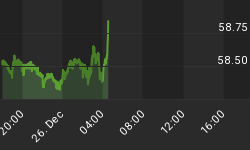Gold has now doubled since the Euro first got where it stands against the Dollar today...
SINCE THIS decade's Dollar Decline first pushed the Euro above $1.35 in late 2004 - a level it reclaimed this week - the price of gold has gone on to double for both US and Eurozone citizens.
American investors and savers would have been much better off Buying Gold instead of Euros, in other words, as would everyone else. And looking ahead, "These days, currency weakness, relative to other currencies, matters less for gold," reckons Standard Bank's Walter de Wet.
"All major currencies are being devalued, and as a result - and on a relative basis - currencies are trading in the same ranges seen before. However, these currencies are weaker against tangible assets such as gold."
| Euro @ $1.35 | Dollar Gold Price | Euro Gold Price |
| Dec. 2004 | $441 | €329 |
| April 2007 | $681 | €504 |
| Oct. 2008 | $900 | €665 |
| May 2009 | $913 | €670 |
The European single currency has in fact averaged $1.35 to the Dollar for the last three-and-half years. Over that same period, gold has pushed up against both, averaging $730 per ounce but standing higher today by one-quarter at $925.
Sticking with the Dollar Down trend, "We expect the Dollar to depreciate to $1.50 by year-end," Standard Bank adds. "As a result, the Gold Price should rise." But by much exactly, if this relationship were to hold good from here...?

Yes, the price of gold in dollars stumbles around the same path as the world's No.1 non-Dollar money when priced in greenbacks. As our chart shows, in fact, gold has loosely mapped the Euro (as figured back to 1979 via the Deutsche Mark's pre-union value) for much of the last 30 years.
Dropping more than half their monthly average, for instance, as the "Super Dollar" marked the global deflation of 1980-85 (or 'disinflation' if you prefer), both gold and its European alternative swung higher...and then lower...to hit bottom at the start of this decade. From there, they've both moved sharply upwards again, breaking new all-time records above their old 1980 highs.
But as de Wet points out, the move in gold has been much swifter than the single currency's gains. "There is better support for gold at the same Dollar/Euro exchange rate," in short. And viewed across the last 30 years, the Gold Price is holding one-third better than its previous high (monthly average).
Europe's official non-Dollar, in contrast, advanced only 4% to its new peak of July 2008.















